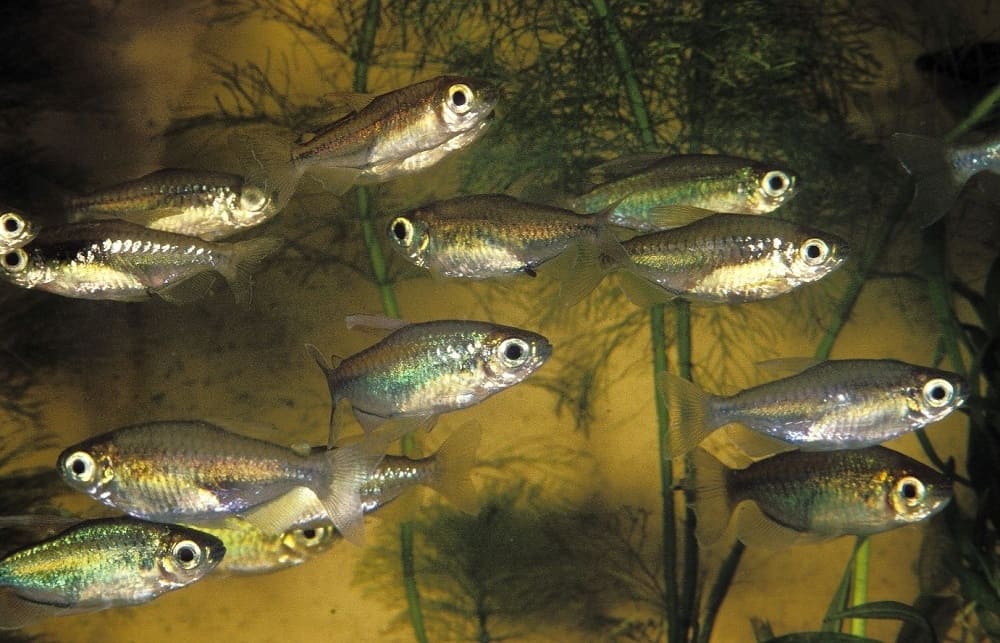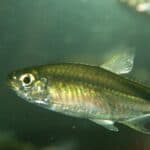The Congo Tetra is considered one of the best and most popular tetras for a home aquarium due to its stunning and striking natural beauty. This colorful kind of fish will surely stand out among the rest in your tank, with a shimmering body and flowing fins.
The good news is that they are also peaceful creatures, and relatively easy to care for. If you’re interested in this fish for your home aquarium, then read on to find out more about the Congo Tetra and how to care for it.

Species Summary
The Congo Tetra hails from, you guessed it…the Congo River in Africa. This type of fish is shining, shimmering and stunning much like its relatives in the tetras of South America.
Upon first glance, you may even think that this fish looks like a rainbow, as the bright colors are designed for courtship and mating displays towards both male and females of this species.
This African fish originates in the Congo River Basin, and will tend to be found in pools, marches, streams, tributaries and murky, more acidic water. They will swim in large schools of multiple fish, congregate in areas with lots of vegetation, and substrates such as sand and mud.
This kind of fish feeds on a variety of sources, including insects, worms, crustaceans, and plant matter such as algae. The Congo Tetra is from the Alestidae family, and is a kind of peaceful schooling fish. As a result, they tend to be moderately simple to care for, and make great additions to your tank.
Care Guide
Tank Size
The best tank size for Congo Tetras is about 30 gallons. They do not need a huge tank, but they will need space to swim around and explore. They are schooling fish, which will need to be kept with other fish, and have plenty of room to swim.
Tank Mates
It is best to keep Congo Tetra with other peaceful community fish. For instance, they will thrive with Neon Tetras, Rainbowfish, Mollies, Ember Tetras, Barbs, Platies, Dwarf Cichlids, Corydoras and other similar fish species.
Same Species Tanks
The best tank mates for Congo Tetra are their own kind. They are schooling fish, and will love being in a group. We advise that you purchase a group of Congo Tetra no smaller than 6 and keep them together in a tank.
Water Parameters
It is vital that you mimic their natural environment to keep your Congo Tetras happy and healthy. To do this, you are best off with warmer tank temperatures and waters that are slightly more acidic.
Congo Tetras will thrive with a water temperature of about 72 degrees fahrenheit to about 82 degrees fahrenheit. 76 degrees is the optimal temperature. They will also need pH levels of about 6.0 to 7.5 but keep to the lower end of this scale if possible.
They also will need a water hardness of 3 to 18 dGH. Make sure that you keep the water consistent at all times.
What To Put In Their Tank
The Congo Tetra loves murky waters in the wild, filled with places to hide. This is why they will love a sandy substrate at the bottom of the tank to mimic a muddy river basin. They will also enjoy lots of floating plants as this would be natural in their wild habitat.
These plants also give the Congo Tetra places to hide if needed, however, you do not want too much vegetation in the tank as they need space to swim. Keep the central area of the tank empty for space, but add vegetation to the sides, or some rocks for hiding places.
Common Diseases
There are no diseases specific to the Congo Tetra, as these can suffer from the same common fish illnesses. For instance, they can be prone to Ich, which can happen due to stress, and can be deadly.
To ensure the health of your fish, monitor them as much as you can, and remember to keep the tank and water conditions pristine.
Food & Diet
Congo Tetras will eat basically anything. They are omnivores in the wild, so can feed on algae, plant matter, insects, crustaceans and whatever else they can find. They will do well on pellets, dried flakes, daphnia brine shrimp and freeze dried bloodworms. It’s best to give them a variety of protein and plant based foods.
Lifespan
When kept in captivity, the Congo Tetra will tend to survive only about 3 to 5 years. However, some can live longer, but it depends on the fish and their living conditions.
With any breed of fish, as long as you keep them healthy, happy and their environment hygienic and of the best quality, you can prolong their lives.
The best way to prolong a Congo Tetra’s life is to keep it captive in a habitat that closely mimics and resembles its natural environment in the wild.
Appearance
The appearance of the Congo Tetra is what makes this fish so iconic and recognizable. They have a sort of iridescent or rainbow colored body, that makes them very unique and sets them apart from other fish in the tank.
The Congo Tetra itself is a rather small fish, with a long and flat body. They actually look kind of compressed in shape. They have large scales, with luminescence along the whole body from the front all the way to the back.
The male Congo Tetra tends to have longer, more elaborate dorsal fins than the females, and they tend to look wispy and flowing when swimming or floating around in the water.
When you look at a Congo Tetra, you will see that the body seems to shimmer in the light as it bounces off their bodies, glowing with shades of gold, blue, and turquoise. It also appears that they have a stripe from head to tail around the midsection of the fish, which will also seemingly glow in the light.
Size
Most Congo Tetras are between about 3 to 3.5 inches long when kept in captivity. They are generally rather small fish, but the Congo Tetra is slightly larger than other tetras in the species.
That being said, if a Congo Tetra resides in its natural habitat in the wild, it can grow to be a bit longer. For instance, some Congo Tetras have been known to reach nearly 4.5 inches! However, when kept in captivity and inside of a tank, this can stunt their growth and they will remain a little bit smaller.
Behavior & Temperament
This type of fish is considered a peaceful one. They are generally calm and simple to care for, however they can become nervous if kept around aggressive fish, and will try to hide and cower away.
This is why it is best to keep the Congo Tetra with others of its kind, along with a tank of peaceful community fish. This will ensure that they are not stressed or anxious, and they can lead happy, calm and normal lives, swimming around your tank gleefully.
The Congo Tetra will love swimming around in schools with other tetras, and will generally remain at the middle and top of the aquarium. Some may break off towards the bottom to explore, but this does not happen very often.
In general, these fish do well in aquariums with lots of room, and when they are the dominant species in the tank, or they may hide and become reclusive.
Breeding
Like many other fish, the Congo Tetra is an egg layer, and adults should be separated from the eggs to prevent them from being eaten. For the Congo Tetra, you will have to invest in a larger breeding tank because they produce around 300 eggs that are very much likely to hatch into fry.
These will grow into fully grown tetras in about five weeks, and so you need to be prepared. We recommend a 15 or 20 gallon tank for breeding, and pack the bottom with about 1 inch of peat moss substrate. Leave the tank cycle for a few days to ensure the water is rich enough for breeding.
Then, you can place a breeding pair of Congo Tetras into the tank, and place the temperature at about 77 degrees fahrenheit, before turning off the lights. When you return the next day, and turn on the lights, it is highly likely that the fish have started to spawn.
This typically happens at the bottom of the tank, in the moss where the female will lay her eggs. Once bred, remove the adults from the tank and the fry should hatch in about a week. These should be fed infusoria initially, before changing over to baby brine shrimp.
Gender Differences: Male vs. Female
When it comes to gender differences, the male Congo Tetra tends to be slightly more colorful than the female. They are also a little larger, flatter, and have fanciful and elaborate fins with an extended caudal fin and a more pronounced and distinctive dorsal fin.
On the other hand, the females have less bright colors, and tend to be shades of gold, silver and green. They are slightly plumper than the males, especially when close to breeding, and do not have the detailed and complex fins that the males do.
Fun Facts
- The Congo Tetra is not a very picky fish and will eat any food that it can get its fins on! In the wild, they eat insects, worms, algae and crustaceans.
- Did you know that the Congo Tetra gets its name from where it is found; the Congo, and its tetra shaped body! Hence… the Congo Tetra!








